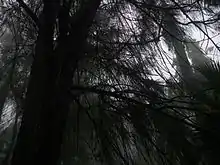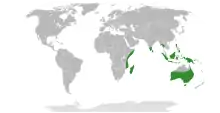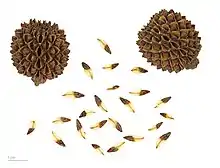Casuarina
Casuarina is a genus of 17 tree species in the family Casuarinaceae, native to Australia, the Indian subcontinent, southeast Asia, islands of the western Pacific Ocean, and eastern Africa. It was once treated as the sole genus in the family, but has been split into four genera (see: Casuarinaceae).[1][3]

| Casuarina | |
|---|---|
 | |
| Casuarina equisetifolia, showing red female flowers and mature fruits | |
| Scientific classification | |
| Kingdom: | Plantae |
| Clade: | Tracheophytes |
| Clade: | Angiosperms |
| Clade: | Eudicots |
| Clade: | Rosids |
| Order: | Fagales |
| Family: | Casuarinaceae |
| Genus: | Casuarina L.[1][2] |
| Type species | |
| Casuarina equisetifolia[2] L. | |
| Species | |
|
See text | |
 | |


They are evergreen shrubs and trees growing to 35 m (115 ft) tall. The slender, green to grey-green twigs bearing minute scale-leaves in whorls of 5–20. The apetalous flowers are produced in small catkin-like inflorescences. Most species are dioecious, but a few are monoecious. The fruit is a woody, oval structure superficially resembling a conifer cone, made up of numerous carpels, each containing a single seed with a small wing.[3][4] The generic name is derived from the Malay word for the cassowary, kasuari, alluding to the similarities between the bird's feathers and the plant's foliage,[5] though the tree is called rhu in current standard Malay.
Karen Louise Wilson and Lawrence Alexander Sidney Johnson distinguish the two very closely related genera, Casuarina and Allocasuarina on the basis of:[6]
- Casuarina: the mature samaras being grey or yellow brown, and dull; cone bracteoles thinly woody, prominent, extending well beyond cone body, with no dorsal protuberance;
- Allocasuarina: the mature samaras being red brown to black, and shiny; cone bracteoles thickly woody and convex, mostly extending only slightly beyond cone body, and usually with a separate angular, divided or spiny dorsal protuberance.
Ecology
Casuarina species are a food source of the larvae of hepialid moths; members of the genus Aenetus, including A. lewinii and A. splendens, burrow horizontally into the trunk then vertically down. Endoclita malabaricus also feeds on Casuarina. The noctuid turnip moth is also recorded feeding on Casuarina.
Pedunculagin, casuarictin, strictinin, casuarinin and casuariin are ellagitannins found in the species within the genus.[7]
Invasive species

C. cunninghamiana, C. glauca and C. equisetifolia have become naturalized in several countries, including Argentina, Bermuda, Cuba, China, Egypt, Israel, Iraq, Mauritius, Kenya, Mexico, Brazil, South Africa, the Bahamas,[8] Uruguay and the southern United States; in the United States it was introduced in the early 1900s, and is now considered an invasive species.[9][10] The species has nearly quadrupled in southern Florida between 1993 and 2005, where it is known as Australian pine.[11] C. equisetifolia is widespread in the Hawaiian Islands where it grows both on the seashore in dry, salty, calcareous soils and up in the mountains in high rainfall areas on volcanic soils. It is also an invasive plant in Bermuda, where it was introduced to replace the Juniperus bermudiana windbreaks killed by a scale insect in the 1940s.[12]
Species List
Casuarina comprises the following species:[1][3][13][14][15][16]
- Casuarina collina Poiss. ex Pancher & Sebert
- Casuarina cristata Miq. (northeastern Australia: Queensland, New South Wales).
- Casuarina cunninghamiana Miq. – river she-oak (northern and eastern Australia: Northern Territory to New South Wales)
- Casuarina equisetifolia L. – beach she-oak, common ironwood, Australian pine (Florida),[11] casuarina, whistling pine[12] (northern Australia, southeastern Asia, doubtfully native to Madagascar), ঝাউ in বাংলা (Bengali), ಗಾಳಿ ಮರ (gaali mara) in Kannada.
- Casuarina glauca Sieber ex Spreng. grey she-oak, longleaf ironwood, saltmarsh ironwood, swamp oak (New South Wales)
- Casuarina grandis L.A.S.Johnson (New Guinea)
- Casuarina junghuhniana Miq. (Indonesia)
- Casuarina obesa Miq. (southern Australia: southwestern Western Australia, New South Wales [one site, now extirpated], Victoria)
- Casuarina oligodon L.A.S.Johnson (New Guinea)
- Casuarina orophila L.A.S.Johnson
- Casuarina pauper F.Muell. ex L.A.S.Johnson (Australia)
- Casuarina potamophila Schltr.
- Casuarina tenella Schltr.
- Casuarina teres Schltr.
Species names with uncertain taxonomic status
The status of the following species is unresolved:[15]
- Casuarina defungens L.A.S. Johnson
- Casuarina hexagona Dehnh.
- Casuarina litorea Rumph.
- Casuarina lucida Dehnh.
- Casuarina prisea Miq.
Formerly placed here
- Allocasuarina acuaria (F. Muell.) L.A.S.Johnson (as C. acuaria F.Muell.)
- Allocasuarina acutivalvis (F. Muell.) L.A.S.Johnson (as C. acutivalvis F.Muell.)
- Allocasuarina campestris (Diels) L.A.S.Johnson (as C. campestris Diels)
- Allocasuarina corniculata (F.Muell.) L.A.S.Johnson (as C. corniculata F.Muell.)
- Allocasuarina decussata (Benth.) L.A.S.Johnson (as C. decussata Benth.)
- Allocasuarina distyla (Vent.) L.A.S.Johnson (as C. distyla Vent.)
- Allocasuarina drummondiana (Miq.) L.A.S.Johnson (as C. drummondiana Miq.)
- Allocasuarina fibrosa (C.A.Gardner) L.A.S.Johnson (as C. fibrosa C.A.Gardner)
- Allocasuarina fraseriana (Miq.) L.A.S.Johnson (as C. fraseriana Miq.)
- Allocasuarina grevilleoides (Diels) L.A.S.Johnson (as C. grevilleoides Diels)
- Allocasuarina helmsii (Ewart & Gordon) L.A.S.Johnson (as C. helmsii Ewart & Gordon)
- Allocasuarina huegeliana (Miq.) L.A.S.Johnson (as C. huegeliana Miq.)
- Allocasuarina humilis (Otto & A. Dietr.) L.A.S.Johnson (as C. humilis Otto & A.Dietr.)
- Allocasuarina inophloia (F. Muell. & F. M. Bailey) L.A.S.Johnson (as C. inophloia F.Muell. & F.M.Bailey)
- Allocasuarina lehmanniana subsp. lehmanniana (as C. baxteriana Miq. or C. lehmanniana Miq.)
- Allocasuarina littoralis (Salisb.) L.A.S.Johnson (as C. littoralis Salisb. or C. suberosa Otto & A.Dietr.)
- Allocasuarina luehmannii (R.T.Baker) L.A.S.Johnson (as C. luehmannii R.T.Baker)
- Allocasuarina muelleriana (Miq.) L.A.S.Johnson (as C. muelleriana Miq.)
- Allocasuarina nana (Sieber ex Spreng.) L.A.S.Johnson (as C. nana Sieber ex Spreng.)
- Allocasuarina paludosa (Sieber ex Spreng.) L.A.S.Johnson (as C. paludosa Sieber ex Spreng.)
- Allocasuarina pusilla (Macklin) L.A.S.Johnson (as C. pusilla Macklin)
- Allocasuarina thuyoides (Miq.) L.A.S.Johnson (as C. thuyoides Miq.)
- Allocasuarina torulosa (Aiton) L.A.S.Johnson (as C. tenuissima Sieber ex Spreng. or C. torulosa Aiton)
- Allocasuarina trichodon (Miq.) L.A.S.Johnson (as C. trichodon Miq.)
- Allocasuarina verticillata (Lam.) L.A.S.Johnson (as C. quadrivalvis Labill., C. stricta Aiton or C. verticillata Lam.)
- Gymnostoma deplancheanum (Miq.) L.A.S.Johnson (as C. deplancheana Miq.)
- Gymnostoma nodiflorum (Thunb.) L.A.S.Johnson (as C. angulata J.Poiss. or C. nodiflora Thunb.)
- Gymnostoma papuanum (S. Moore) L.A.S.Johnson (as C. papuana S.Moore)
- Gymnostoma rumphianum (Miq.) L.A.S.Johnson (as C. rumphiana Miq.)
- Gymnostoma sumatranum (Jungh. ex de Vriese) L.A.S.Johnson (as C. sumatrana Jungh. ex de Vriese)[13]
References
- Australian Plant Name Index (APNI): Casuarina IBIS database. Centre for Plant Biodiversity Research, Australian Government. Retrieved 3 November 2018.
- Linnaeus, C. (1759), Amoenitates Academicae 4: 143
- Flora of Australia: Casuarina
- Huxley, A., ed. (1992). New RHS Dictionary of Gardening. Macmillan Publishers. ISBN 0-333-47494-5.
- Quattrocchi, Umberto (2000). CRC World Dictionary of Plant Names. I A-C. CRC Press. p. 456. ISBN 978-0-8493-2675-2.
- Wilson, K. L.; Johnson, L. A. S. (1989). "Flora of Australia online: Casuarinaceae". ABRS, Commonwealth of Australia. Retrieved 3 November 2018.
- Okuda, T.; T. Yoshida; M. Ashida; K. Yazaki (1983). "Tannins of Casuarina and Stachyurus species. I: Structures of pendunculagin, casuarictin, strictinin, casuarinin, casuariin, and stachyurin". Journal of the Chemical Society (8): 1765–1772.
- "Archived copy". Archived from the original on 2011-07-06. Retrieved 2008-10-04.CS1 maint: archived copy as title (link)
- USFS FEIS: Casuarina
- USDA Forest service: Casuarina
- IFAS: SRFer Mapserver Archived 2007-09-07 at the Wayback Machine
- "Casuarina (Casuarina equisetifolia)". Department of Conservation. Government of Bermuda. Archived from the original on 2010-03-05. Retrieved 2010-10-01.
- "GRIN Species Records of Casuarina". Germplasm Resources Information Network. United States Department of Agriculture. Archived from the original on 2009-01-20. Retrieved 2011-02-18.
- "Casuarina". Integrated Taxonomic Information System. Retrieved 2010-02-21.
- "The Plant List entry for Casuarina". The Plant List, v.1.1. Royal Botanic Gardens, Kew and the Missouri Botanical Garden. September 2013. Retrieved 14 December 2020.
- Govaerts R. "Casuarina L.". Plants of the World Online. Board of Trustees of the Royal Botanic Gardens, Kew. Retrieved 14 December 2020.
| Wikimedia Commons has media related to Casuarina. |
| Wikispecies has information related to Casuarina. |